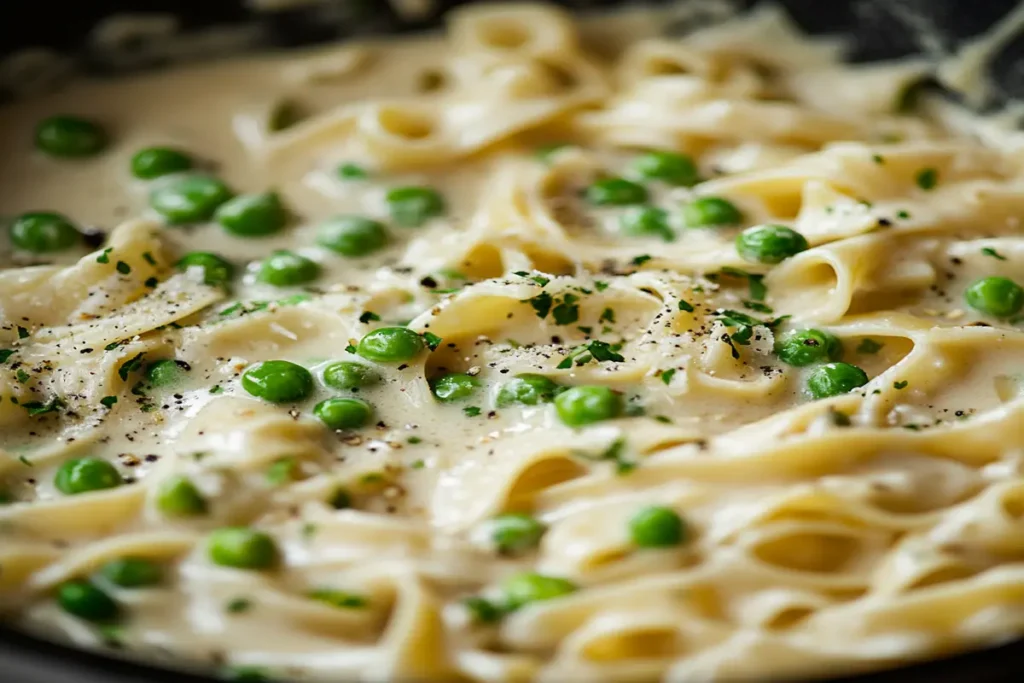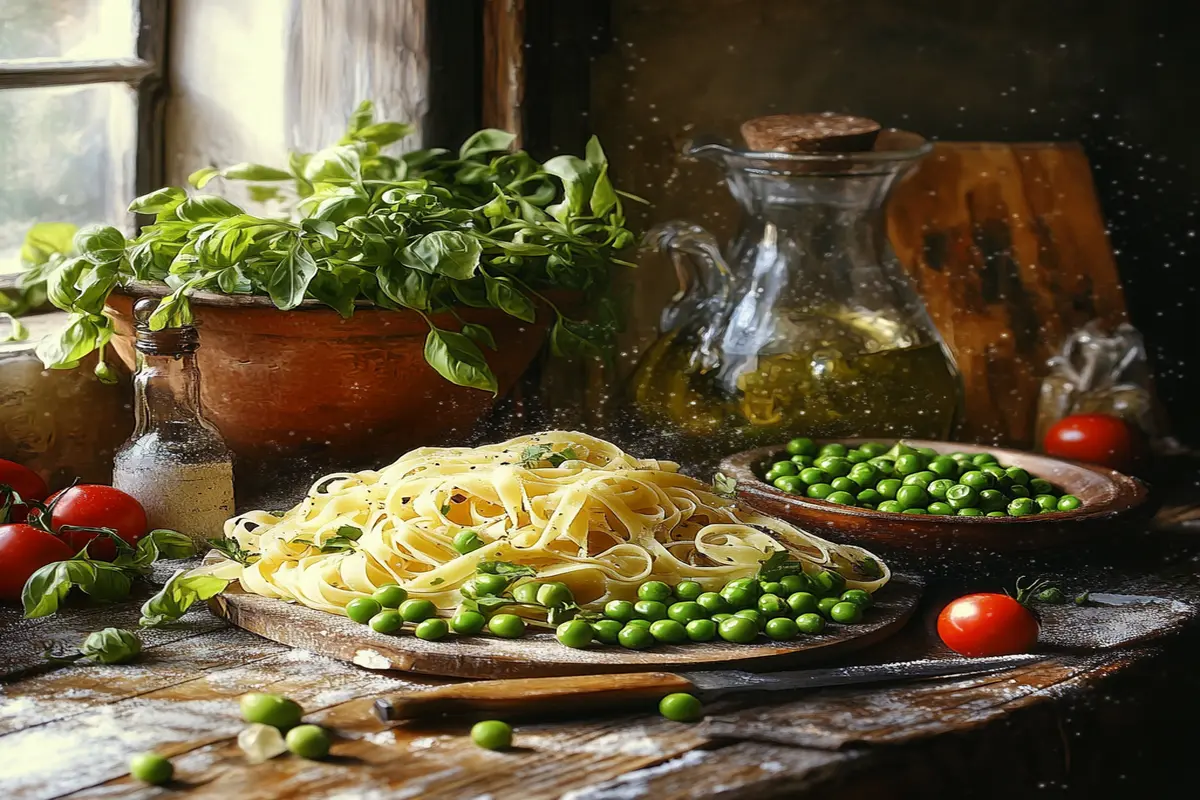Looking for a comforting, easy-to-make meal that never goes out of style? You’re in for a treat! This article is your ultimate guide to mastering the pasta and peas recipe. From understanding the origins of this hearty dish to crafting it step by step, you’ll learn everything you need to know. Along the way, we’ll explore tips to elevate the flavor, variations to suit every diet, and answers to common questions like “Do Italians put peas in pasta?” By the end, you’ll not only have a delicious dish on your table but also a new favorite go-to recipe. Let’s dive right in!
: Introduction to Pasta and Peas Recipe
What is Pasta and Peas?
Pasta and peas, or pasta e piselli in Italian, is a simple yet flavorful dish originating from the heart of Italian cuisine. It’s a humble meal that combines pantry staples like pasta, peas, and olive oil to create a warm, comforting dish. Often referred to as a “poor man’s dish,” its beauty lies in its simplicity and versatility.
Whether served as a quick weekday dinner or a cozy meal on a chilly night, this dish has stood the test of time for its satisfying flavors and minimal preparation.
Why is Pasta and Peas a Classic Dish?
What makes this dish a classic is its universal appeal. It’s an ideal choice for home cooks because it requires only a handful of ingredients, yet it delivers a hearty, filling meal. Italians have long celebrated the beauty of seasonal ingredients, and peas often find their way into the dish when fresh and tender during spring. However, frozen peas work perfectly, making this dish an all-year-round favorite.
The creamy texture of the dish, achieved without heavy creams, and its mild sweetness from the peas pair wonderfully with the chewy pasta. Plus, it’s a vegetarian-friendly recipe that can be easily adapted for vegan or gluten-free diets.
The Appeal of Pasta and Peas Around the World
Although it has Italian roots, pasta and peas have earned fans across the globe. Its adaptability allows cooks to tweak it to fit their tastes—adding protein, spices, or other vegetables. In regions where Italian cuisine is celebrated, this dish serves as a reminder of how a simple recipe can turn into something extraordinary.
It’s no wonder pasta and peas is often dubbed as comfort food at its finest. Whether you’re a seasoned chef or a beginner in the kitchen, this dish is your ticket to a meal that’s both satisfying and easy to prepare.
The Ingredients You Need for a Perfect Pasta and Peas Dish
Essential Ingredients for Authentic Flavor
Creating a flavorful pasta and peas recipe starts with the right ingredients. The essentials include pasta (such as ditalini or small shells), peas (fresh, frozen, or canned), olive oil, garlic, onion, and Parmesan cheese. These staples come together to deliver the signature creamy texture and delightful balance of sweet and savory.
For the best results, use high-quality pasta and extra-virgin olive oil to enhance the dish’s overall flavor. Opt for fresh peas during the spring or frozen ones for convenience. If using canned peas, rinse them thoroughly to remove excess salt.
Choosing the Right Pasta for Your Recipe
The type of pasta you use can significantly affect the final dish. Traditional pasta and peas recipes often call for small, tubular shapes like ditalini or elbow macaroni. These varieties help capture the peas and sauce, ensuring every bite is bursting with flavor.
However, don’t hesitate to experiment! Shells, orecchiette, or even gluten-free options work well, allowing you to tailor the dish to your dietary preferences. Whatever pasta you choose, cook it al dente to maintain its texture.
Optional Add-Ins for Creativity
While the classic recipe is delightfully simple, there’s plenty of room to get creative. Consider adding pancetta or bacon for a smoky twist, or toss in herbs like parsley and basil for a fresh pop of flavor. A splash of cream or a dollop of ricotta can make the dish rich and decadent. Feeling adventurous? Stir in crushed red pepper for a spicy kick.
For more creative recipe ideas, check out this guide on steak pasta recipes, which offers innovative twists on classic pasta dishes.
Step-by-Step Guide to Making Pasta and Peas
Preparation: Getting Started with the Ingredients

Before you start cooking, gather all your ingredients. Mince the garlic and onion, measure out the peas, and set aside your pasta. This step ensures a smooth cooking process and minimizes stress in the kitchen.
If you’re using fresh peas, blanch them in boiling water for 2–3 minutes to preserve their vibrant green color. For frozen peas, simply rinse them under cold water to remove any frost.
Cooking the Pasta to Perfection
Boil a large pot of salted water, then add your pasta. Cooking it al dente is crucial—it ensures the pasta retains its structure and absorbs the flavors of the sauce later on. Reserve a cup of pasta water before draining; it’s a secret weapon for adjusting the consistency of your sauce.
Making the Pea Sauce or Base
Heat olive oil in a large skillet over medium heat. Sauté the garlic and onion until fragrant and golden, about 2–3 minutes. Add the peas and a ladle of pasta water, then simmer for 5 minutes. If you prefer a creamy sauce, mash some peas with the back of a spoon to release their starches.
Season with salt, pepper, and a pinch of red pepper flakes for a subtle heat. You’ll notice the sauce thickening as the peas cook down.
Combining Pasta and Peas for the Final Dish
Add the cooked pasta to the skillet, tossing to coat each piece evenly in the sauce. Gradually add reserved pasta water as needed to achieve your desired consistency. Sprinkle in freshly grated Parmesan cheese and stir until it melts, creating a velvety sauce.
For an added touch, drizzle with olive oil and garnish with parsley before serving. This step elevates the flavors and gives the dish a restaurant-quality finish.
Tips and Tricks for Elevating Your Pasta and Peas Recipe
How to Add Depth of Flavor with Herbs and Spices
To take your pasta and peas recipe to the next level, seasoning is key. While the classic combination of garlic, onion, and olive oil is delightful, adding herbs like basil, parsley, or thyme can enhance the dish. A sprinkle of Italian seasoning or freshly cracked black pepper gives it a deeper aroma.
For a bold flavor profile, toss in a pinch of nutmeg or crushed red pepper. These spices complement the sweetness of the peas, adding warmth to the dish. If you’re feeling adventurous, consider finishing your dish with a drizzle of truffle oil—it’s a luxurious way to add an earthy depth.
Using Broth Instead of Water for Cooking
One pro tip that guarantees a richer taste is cooking your pasta in broth instead of plain water. Vegetable or chicken broth infuses every bite with a savory depth that plain salted water just can’t match. If you prefer a lighter dish, use half broth and half water.
Don’t forget to save some broth when draining your pasta! It works wonders for loosening up the sauce and blending flavors seamlessly.
The Role of Cheese: Parmesan, Pecorino, and Alternatives
Cheese is the crown jewel of a good pasta and peas recipe. Parmesan is a traditional favorite, but Pecorino Romano’s slightly salty tang adds an exciting twist. For a creamier version, mix in mascarpone or ricotta during the final toss.
If you’re avoiding dairy, try nutritional yeast. It provides a cheesy flavor without the lactose. For those experimenting with plant-based diets, this substitution allows you to maintain the dish’s iconic creaminess.
Variations of Pasta and Peas Recipes to Try
Classic Italian Style with Simple Ingredients
For a truly authentic experience, stick to the basics. Classic pasta and peas recipes rely on just a few ingredients: pasta, peas, olive oil, garlic, and Parmesan. This straightforward approach lets the natural sweetness of the peas and the salty richness of the cheese shine through.
Creamy Pasta and Peas for a Rich Twist
If you prefer a heartier dish, a creamy version might be your favorite. Add a splash of heavy cream or half-and-half to the pea sauce for an indulgent texture. You can also blend a portion of the cooked peas with the cream to create a silky, pea-flavored base.
Gluten-Free and Vegan Options
Dietary restrictions don’t mean you have to miss out on this comforting dish! Use gluten-free pasta made from rice, corn, or even chickpeas to keep the recipe accessible. Replace Parmesan with nutritional yeast or a vegan cheese alternative for a plant-based twist.
For the sauce, substitute olive oil and broth for any dairy products. You’ll still enjoy the creamy goodness while staying true to your dietary needs.
Adding Protein: Pancetta, Bacon, or Chicken
Want to make your pasta and peas recipe more filling? Adding protein like crispy pancetta, smoky bacon, or shredded rotisserie chicken can turn it into a complete meal. Cook the protein separately, then mix it in when combining the pasta and sauce for a burst of savory flavor.
The Nutritional Benefits of Pasta and Peas
Health Benefits of Peas: Protein and Fiber
Peas are more than just a colorful addition to your pasta and peas recipe—they’re a powerhouse of nutrition. Packed with plant-based protein, peas are a great way to make your meal more filling without relying on meat. They’re also rich in dietary fiber, which promotes digestion and helps you feel full longer.
In addition, peas are low in fat and calories, making them an excellent choice for maintaining a healthy weight. Their natural sweetness pairs perfectly with pasta, creating a balanced dish that’s both tasty and nutritious.
Is Pasta Made from Peas Healthy?
If you’re looking to boost the health benefits of your dish, consider using pasta made from peas. It’s gluten-free and higher in protein compared to traditional wheat-based pasta. This alternative is ideal for anyone following a low-carb or gluten-free diet while still craving a comforting bowl of pasta and peas.
Pea pasta is also rich in essential nutrients like iron and potassium. These nutrients help support energy levels and maintain healthy muscles, making your meal both delicious and good for you.
Balancing Nutrition in Your Recipe
To create a well-rounded dish, balance the carbs from pasta with the protein and fiber from peas. Adding a handful of fresh spinach or arugula can up the vitamin content, while topping the dish with a sprinkle of nuts or seeds provides healthy fats. These small additions can transform your meal into a nutrient-packed powerhouse.
By choosing high-quality ingredients and keeping portion sizes in check, you can enjoy your pasta and peas recipe as a guilt-free comfort food.
Common Questions About Pasta and Peas Recipe (FAQs)
Do Italians Put Peas in Pasta?
Yes, they do! The combination of pasta and peas is a beloved Italian tradition, especially in southern regions like Naples. Known as pasta e piselli, this dish celebrates simple, seasonal ingredients. It’s often made with just a handful of pantry staples, highlighting the beauty of Italian cuisine’s minimalist approach.
What Can I Add to Pasta to Make It More Interesting?
There are endless ways to jazz up your pasta and peas recipe. Adding pancetta, bacon, or chicken can make it heartier, while fresh herbs like parsley or basil add vibrant flavor. A dash of lemon juice or zest brightens the dish, and crushed red pepper flakes give it a spicy kick.
Is Pasta Made from Peas Healthy?
Absolutely! Pasta made from peas is an excellent option for those seeking more protein and fiber in their diet. It’s gluten-free, lower in carbs, and packed with nutrients, making it a great alternative for health-conscious eaters.
How to Spice Up Canned English Peas?
Canned peas can be elevated with a few simple tricks. Sauté them with garlic and olive oil, toss them with a splash of broth, or mix them with freshly grated Parmesan cheese. These additions bring out their flavor and make them a star ingredient in your dish.
These FAQs address common curiosities and offer practical tips to make your pasta and peas recipe even more delightful. Let’s explore how to pair and serve this dish in the next part!
Pairing Suggestions and Serving Ideas for Pasta and Peas
Side Dishes to Complement Pasta and Peas

When serving a comforting dish like the pasta and peas recipe, pairing it with the right sides can create a well-rounded meal. Garlic bread or a simple green salad with a tangy vinaigrette are excellent options. These sides balance the creaminess of the pasta and add texture to your plate.
For something more substantial, roasted vegetables like zucchini, carrots, or bell peppers make a colorful and flavorful addition. The roasted flavor complements the sweetness of the peas and enhances the overall dish.
Serving Wine or Beverages with Pasta and Peas
Wondering what to drink with your pasta and peas recipe? A crisp white wine, such as Sauvignon Blanc or Pinot Grigio, pairs wonderfully with the light and creamy flavors. If you prefer non-alcoholic options, sparkling water with a twist of lemon or iced herbal tea works just as well.
Making It a Full-Course Meal
Transform your meal into a full-course experience by starting with an antipasto platter of olives, cheeses, and cured meats. Follow your pasta and peas recipe with a light dessert like sorbet or panna cotta for a delightful Italian-inspired feast.
Troubleshooting and Common Mistakes in Pasta and Peas Recipes
Avoiding Overcooked Pasta
Overcooked pasta can quickly ruin the texture of your pasta and peas recipe. To avoid this, always cook pasta until it’s al dente. This not only preserves its firmness but also allows it to absorb the flavors of the sauce without becoming mushy.
If you’re using small pasta shapes, be especially mindful of the cooking time, as they can cook faster than larger varieties.
Fixing a Bland Sauce: Quick Remedies
A bland sauce can make your dish fall flat, but don’t worry—it’s easy to fix. Add a pinch of salt or Parmesan to boost the flavor instantly. For more depth, incorporate a splash of lemon juice, a drizzle of olive oil, or a sprinkle of red pepper flakes.
If you’re thinking, What can I add to pasta to make it more interesting? consider garlic, fresh herbs, or even a touch of balsamic glaze for a unique twist.
Common Ingredient Substitutions
Running out of an ingredient doesn’t mean you can’t enjoy your pasta and peas recipe. Substitute fresh peas with frozen ones, or use pecorino cheese if Parmesan isn’t available. For added creaminess, mix in Greek yogurt or a dairy-free alternative if you’re avoiding cream.
These tips ensure your dish turns out perfect every time, no matter the challenge. Let’s wrap things up in the final part!

